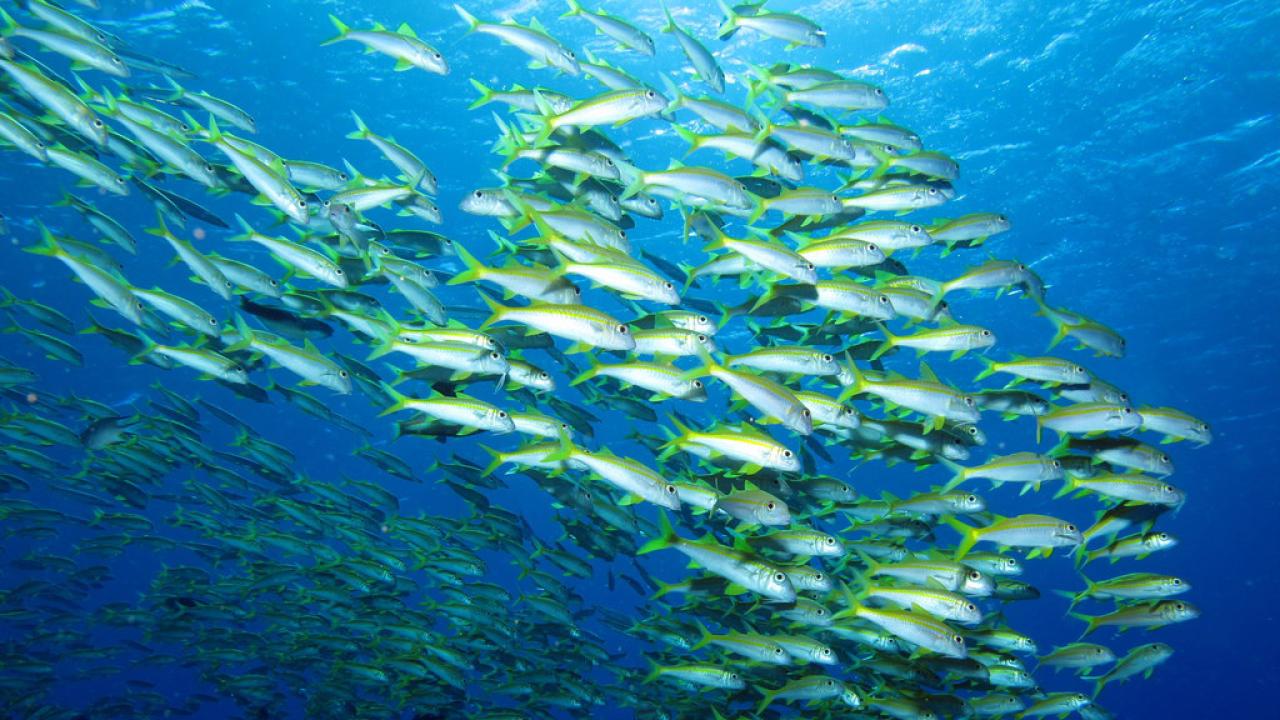
What happens when a biologist, a physicist, and a roboticist walk into a room? Despite sounding like the start of a joke, this is how a recent conference at ICTP started. Collective behavior was the shared interest of these scientists: exemplified in the way that large numbers of fish and birds move together perfectly synchronized and coordinated in flocks and schools. This self-organization emerging in large groups of individuals is a prime example of collective behavior, which arises in many other contexts, both large and small.
Collective behavior is not restricted to one field of science. Scientists who do not share common techniques or terminology, let alone fields, have found that they are investigating some of the same questions. For instance, how is information transferred through a group? That group could be a group of human cells, a flock of birds, or a group of atoms in a ferromagnetic system, but all exhibit collective behavior. This led conference organizers to reach across scientific field boundaries to hold a meeting based around questions about collective behavior. Roboticists, biologists, and physicists were in equal attendance at the conference, which was co-organized by ICTP’s Asja Jelic and Antonio Celani of the Quantitative Life Sciences section.
Collective behavior examples, regardless of time scale or size, share some common characteristics: individuals interact with neighboring individuals, and certain patterns emerge among the whole group. That self-organization arises without top-down commands or planning. But it’s unclear how information gets passed from individual to individual, or how behavior “decisions” are made. Other questions include how variation among individuals affects group decision making, and how groups interact with their surroundings. How do groups collectively sense outside stimuli and occurrences? How do groups collectively evade predators? All of these questions, and more, were the subject of ICTP's week-long conference.
Some conference participants were joining a growing trend of physicists modeling biological systems to understand underlying principles, while others had found examples of collective behavior in the particles or systems they studied. The hope for physicists is that the complicated details of individuals are not important when looking at collective properties, explains Irene Giardina, a physicist at the University of Rome and a co-organizer of the conference. Potentially, behavior can be characterized in terms of general principles, she says, similar to the approach taken in condensed matter physics, except the subject is the behavior of materials and substances.
This conference was one of a small wave of scientific meetings that are focusing on collective behavior. Inviting scientists who work on similar questions from the angles of different fields reveals that the traditional categories of academia are beginning to blur. “We all read each other’s papers,” says Giardina, “but it’s good to have a way to make connections and have discussions, especially for PhD students and post-docs.” Courses and degrees are still in fairly delineated fields, she says, and the conference exposes them to how interdisciplinary the work is becoming.
“It is increasingly obvious that we’re talking about the same issues across fields,” said Ian Couzin, a co-organizer of the conference. “Instead of us going to our disciplinary conferences, it makes much more sense for us to try to look for the connections between these disciplines.”
Couzin is a researcher at the Department of Collective Behaviour at University of Konstanz/the Max Planck Institute of Ornithology in Germany, but his group primarily works with invertebrates and fish instead of birds. “If it’s collective, and a great system for asking questions, then it is of interest to us,” the group website explains. Couzin’s group uses both theoretical and experimental methods to investigate how social influences shape biological processes in a variety of biological systems, from fish to cells to people.
Conference co-organizer Dario Floreano is the director of the Laboratory of Intelligent Systems at École Polytechnique Fédérale de Lausanne in Switzerland, which “investigates the future of artificial intelligence and robotics at the convergence of biology and engineering, humans and machines.” This apt appointment is just one place where robotics researchers are drawing inspiration from nature. Building artificial swarms of tiny robots that work similarly to flocks of birds is only the start, and the underlying principles of collective behavior are also of great interest to scientists attempting to build robotic networks modeled after real ones.
“The roboticists at this conference are very practical, they build robots that are flying, they are rolling, they are swimming. The underlying principle is that each robot has simple sensors and simple capabilities, but by connecting and exchanging information, hopefully a group can do more than what a single robot can do,” says Floreano.
“There are also some examples of robots interacting with organisms,” says Couzin. “If you are trying to interrogate how organisms are behaving, it can actually be very fruitful to have robots in the loop with the real organisms.” It’s increasingly common for a single lab to work with tools from physics, biology, computer science, robotics, and other fields to investigate their chosen questions, explains Couzin. “It’s much easier now to do research that has a robotics component.”
“The interesting part of this conference is really how it brings together very diverse communities,” says Floreano. “In my opinion this is one of the first or few that have brought together these communities, and I think it shows an open mind among researchers.”
----Kelsey Calhoun













